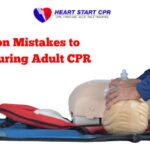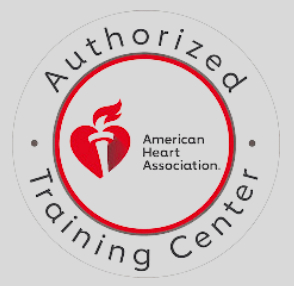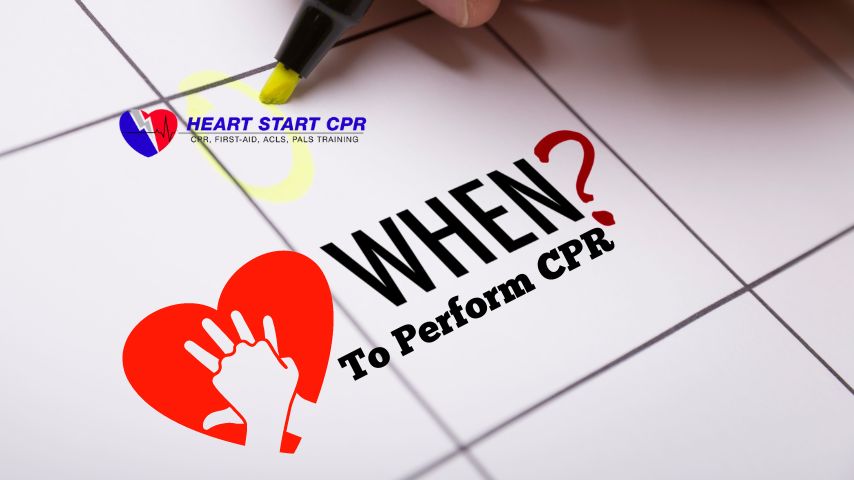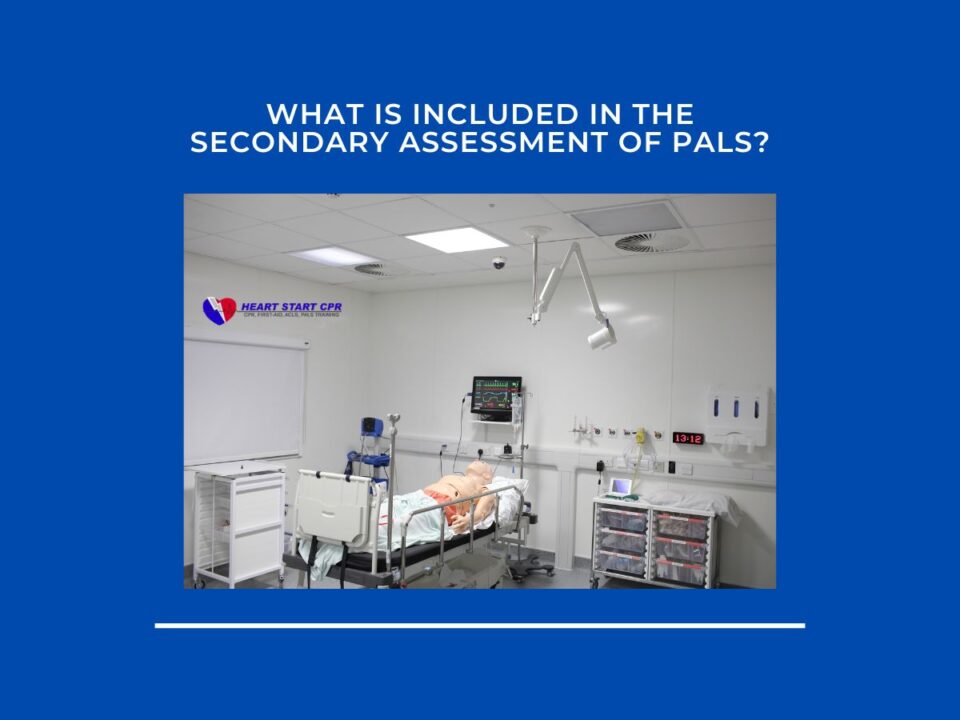
How Can You Achieve a High Chest Compression Fraction?
May 23, 2024
What are the Common Mistakes to Avoid During Adult CPR?
June 4, 2024Table of contents
- 1. Sudden Unconsciousness
- 2. No Breathing
- 3. Limited Breathing
- 4. No Pulse
- 5. Cardiac Arrest
- 6. Choking
- 7. Suffocation
- 8. Drowning
- Why are the First Few Minutes Most Important for Giving CPR?
- When Should You Not Perform CPR?
- When Should You Stop Performing CPR?
- What to Do if You Can’t Perform CPR
- Why Learn CPR?
- Frequently Asked Questions(FAQs)
CPR stands for Cardiopulmonary resuscitation. CPR is a life-saving technique used in emergencies to restore the victim’s blood circulation and breathing in case of sudden cardiac arrest.
Every day, a number of sudden cardiac arrest occurs outside the hospital premises. According to the American Heart Association-AHA, Some 350,000 cases occur each year outside of a hospital, and the survival rate is less than 12 percent. However, the survival rate can be increased by initiating CPR immediately.
Learning the simple skill of when and how to perform CPR could double or triple the victim’s chance of survival. The truth is that the skill of performing CPR is not just for the stranger; it could also be for a family member or friend in need. Take a look at the following situations where CPR might be needed.
1. Sudden Unconsciousness
Sudden unconsciousness occurs when the victim doesn’t respond to any signs and signals. Dehydration, heart failure, Reflex syncope, Diabetes, Psychological Stress, etc., maybe some of the reasons behind the sudden unconsciousness. The victim’s consciousness can be checked by tapping the shoulder or shouting the name. If the victim does not respond, then CPR might be needed.
2. No Breathing
No breathing, also known as Apnea, occurs when a person stops breathing while sleeping and airflow through the lungs stops. Heart failure, Narrow airway, Nasal congestion, Overweight, and Hormonal change are some factors responsible for the no breathing. The difficulty in breathing can lead to several health consequences or even death if not addressed immediately. If someone is not breathing, it is an emergency situation, and CPR should be started immediately.
3. Limited Breathing
Limited breathing is when people feel they can’t get enough air into and out of their lungs. Normal Breathing is essential for the proper functioning of the body’s vital organs. High altitude, Carbon monoxide poisoning, Pneumonia, Asthma, etc. may be some reasons behind limited breathing. CPR is needed in limited breathing conditions to restore oxygen circulation in the body and bring the patient back to life.
4. No Pulse
Showing no sign of a pulse on the victim’s hand or neck is a very serious emergency situation. Low blood pressure, dizziness, fainting, viral infections, and blood clots in the lungs may be some reasons behind the lack of pulse. The patient showing no sign of pulse should be immediately treated with CPR to restore the pulse and save the patient’s life.
5. Cardiac Arrest
Cardiac arrest is the most common situation in which CPR is needed. Diabetes, High cholesterol, Valvular heart disease, stress, High blood pressure, etc., may be some causes of cardiac arrest. Initiating CPR at the right time restores the blood-pumping capacity of the lungs and brings the patient back to life. CPR can temporarily treat Cardiac arrest until the further help arrives.
6. Choking
Choking occurs when a person cannot speak properly, cough, or breathe due to an obstruction caused by an external object in the airway. It’s a very common problem that many individuals may deal with in their lives. Fast eating, not chewing food properly, and large tonsils are some major causes of choking. Knowing what to do if someone is choking is crucial. If a person cannot recover immediately and becomes unconscious, then immediate CPR is needed from an expert.
Must Read: What Should You Do Before Giving Breaths to an Unresponsive Choking Person
7. Suffocation
Suffocation occurs when someone does not get a sufficient quantity of oxygen required for human survival. Strangulation and being trapped in a room with no ventilation are some major causes of suffocation. Suffocation should be treated immediately to restore the oxygen in the body of the victim. If a victim cannot recover from the suffocation and the condition becomes worse, CPR should be provided immediately.
8. Drowning
Drowning occurs when a person has breathing problems after being submerged or immersed in water for a very long time. During drowning, the victim inhales a large amount of water into the body, which causes problems in breathing. CPR should be immediately provided to restore the body’s oxygen to normal and save the life of a drowning person.
Why are the First Few Minutes Most Important for Giving CPR?
The first few minutes are very critical while delivering CPR. During the initial phase, the heart completely goes into Cardiac Arrest, so it cannot pump blood successfully. Providing immediate CPR to the patient can restore the circulation of oxygenated blood to the vital organs of the body, like the brain.
Most Cardiac Arrest treatments can be successful if CPR is provided in time to the patients. Providing CPR in the first few minutes of the Cardiac Arrest buys the most valuable time for the patients and increases the chance of survival.
When Should You Not Perform CPR?
The fact is knowing when you should not perform CPR is as important as knowing when to perform CPR. CPR contributors should be sure about the need for CPR before delivering it. Performing CPR is not recommended in certain situations and could even worsen the condition of the victim and CPR contributor.
However, there are certain situations where performing CPR is not recommended, like:
- Death: A victim showing no sign of life indicates death. Other factors indicating clear death are cold skin, Rigor mortis, livor mortis, and decomposition, etc. Performing CPR is not recommended as it could expose rescuers to health risks. The health risk occurs if the cause of death is infectious or hazardous.
- Normal Breathing: Performing CPR in case of normal breathing could escort to unnecessary complications like broken ribs or damaged lungs. In fact, it could also stand in the way of regular breathing patterns and even worsen the condition. In such a situation, it’s better to call 911 and keep an eye on victim until additional help arrives.
- In case of poisoning: Being poisoned can be life-threatening, and do not try to treat them yourself. CPR is not recommended for acute poisoning cases. In such a situation, One should not give anything by mouth to the victim. It’s better to call for help and observe the victim’s condition.
- Unsafe location: This might sound wild, but rushing to provide CPR without observing the surrounding condition can risk the life of both the rescuer and the victim. For instance, in the case of a massive fire, first evacuate yourself and your victim. Providing CPR near the fire and smoke is not recommended for the safety of both the victim and the rescuer.
- EMS Arrived: The moment EMS-Emergency Medical Services arrives on site, your work is over, and you can step back. The further continuity of CPR can worsen the condition of the victim and can interface with the EMS treatment procedure. After the arrival of EMS services, your part of the work is over, and further on, trained medical professionals will take over.
Read in Detail 5 Situations When You Do Not Perform CPR
When Should You Stop Performing CPR?
You should stop performing CPR in the following conditions:
Sign of life: If a victim shows a sign of life, such as moving, eye-opening, moaning, breathing independently, etc
- Death of Victim: If a medical professional declares the death of the victim, you should stop performing CPR.
- Medical Interference: When you are performing CPR and a trained medical professional arrives on site, it’s time to step back and stop CPR.
- AED Availability: When AED is available and ready for use, you should stop performing CPR.
Also, it’s better if you avoid common mistakes during CPR. If errors occur, they can further decrease the chances of a positive outcome. If you find yourself making mistakes during CPR, stop performing CPR and immediately call emergency services for professional assistance.
What to Do if You Can’t Perform CPR
Here’s the thing, if you encounter yourself in a medical emergency where giving CPR isn’t advisable or possible, your first action should be to call your local emergency number and wait for EMS service to arrive on site. Believe it or not, even if you cannot perform CPR, you can still save the life of the victim. Until further medical service arrives, you can check the consciousness of the victim by tapping on their shoulder or by shouting their name. Make them feel that you are with them and that further medical assistance is arriving as soon as possible. Once the medical assistant arrives, narrate the situation to the medical staff and provide the data needed for the treatment, such as age, blood group, height, blood pressure, etc. After the medical assistant takes over the situation, your work is over, and you can step back.
Why Learn CPR?
You might be asking yourself, why should I learn CPR and Basic life support skills? It’s no surprise that an emergency can occur any time and anywhere and spare no one. Knowledge of CPR and basic life support skills can be life-saving tools in such emergency situation providing valuable time until further help arrives on site. Sudden unconsciousness, cardiac arrest, choking, and suffocation, etc are some instances where the need for CPR and basic life support skills are required to save the victim’s life as described above.
Heart Start CPR provides CPR and Basic Life Support Skills training for medical professionals and non-medical professionals by qualified professionals. With us, you gain the necessary knowledge and courage to handle the critical situation.
Heart Start CPR trains over 6000 students annually with 100% passing rate.
Join our online BLS class anytime and anywhere for those who need BLS Certification.
Also, check out AHA BLS Classes for Healthcare Providers and Onsite CPR Training in the Bay Area
Frequently Asked Questions(FAQs)
When Should You Stop Performing CPR?
We should stop performing CPR in the following two cases:
a. If the victim’s heart starts beating again and they start breathing independently.
b. If medical professionals declare the victim is dead.
Can CPR bring back a pulse?
Yes, in some cases. If a victim’s heart is beating faintly, then CPR could help to recover and regain a pulse.
What are the steps of CPR?
The steps for performing CPR are given below:
a. Call 911 for further help.
b. Lay the victim on their back.
c. Clear the victim’s airway by using the head tilt-chin lift.
d. Provide 30 chest Compressions.
e. Go for Two rescue breaths.
f. Repeat the procedure until further medical assistance arrives.
Can we do CPR if someone is still breathing?
CPR is not recommended if someone is breathing normally.
What pulse do you check before CPR?
We check for the Carotid Pulse. The carotid pulse is a pressure sensation that can be detected in the carotid arteries on both sides of the neck, just beneath the jawline.
Do you check breathing or pulse first?
We check for the pulse first, starting from the center of the neck.
What two things you should ask someone to do before you start CPR?
One should check the consciousness of the victim before performing CPR by asking the victim’s name and tapping on their shoulder.






